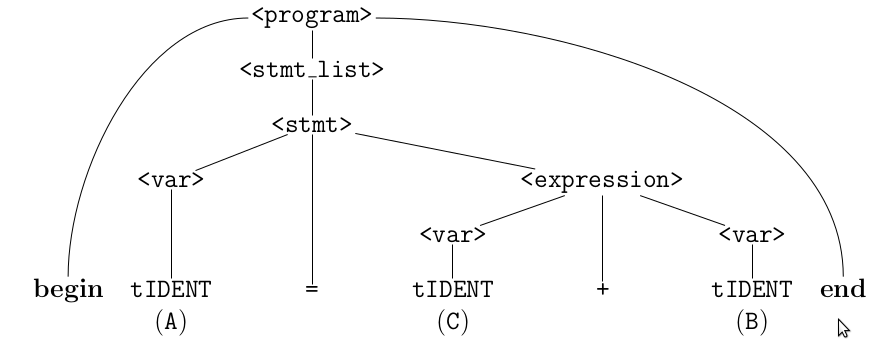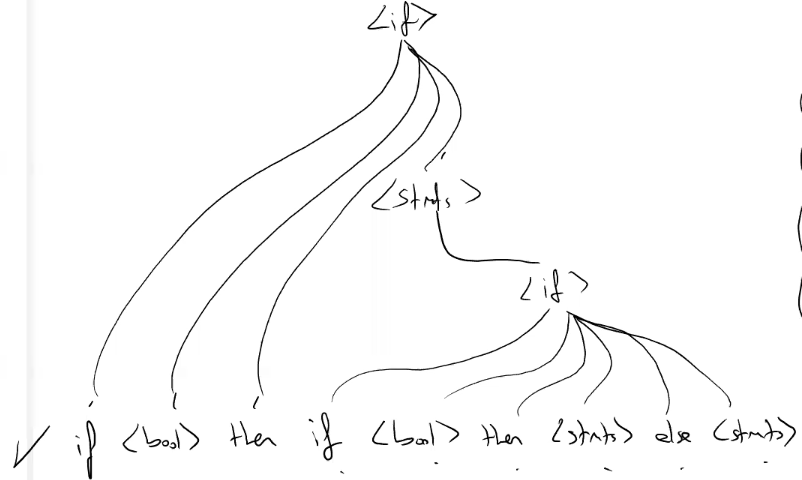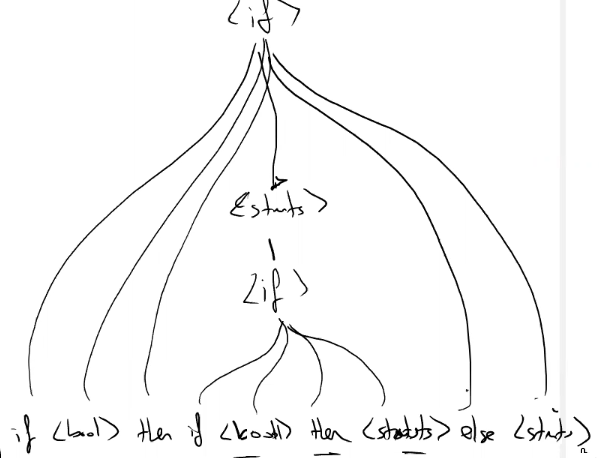Context Free Grammer
2020-07-23 |- Terminal Symbols = token
- Non-terminal Symbols = abstractions, inside of "< >"
In formal language theory, a context-free grammar (CFG) is a formal grammar whose production rules are of the form
A => a
- A: Non terminal
-
a: terminals
-
Abstraction:
<assign>is a abstraction - Production:
<assign> -> <var> = <expression>
Example production:
<assignment> -> tID tASSGN tID; // For first assignment statement
<assignment> -> tID = tID + tID; <-- Production 1
| tId = tID; <-- Production 2
But also we can write some type statement x = y + z * x So we should have write our production to handle more complex statements. So recursion can help us.
<assignment> -> tID = <expr>
<expr> -> tID // Recursive role
| <expr> + <expr>
| <expr> * <expr>
Derivations
- All CFG starts with start symbol
- Sentential form: A sentential form is any string derivable from the start symbol [wpi.edu]. applying productions to nonterminals in a sentential form. (recursively)
- Example: Let's take
<program>a start symbol. Sentential forms can be :
begin <stmt_list> end OR
begin <stmt> ; <stmt_list> end
- We can generate multiple sentential forms of a program with openin productions which called as derivation.
- We use
==>to express derivation.
begin <stmt list> end ==> begin <stmt> ; <stmt list> end
Leftmost Derivation
- If we derive from left-hand side it will become leftmost derivation.
- Leftmost sentential form
<program> ==> begin <var> = <expr> end
==> begin tIDENT = <expr> end
==> begin tIDENT = <var> + <var> end
==> begin tIDENT = tIDENT + <var> end
......
Rightmost Derivation
- If we derive from right-hand side it will become rightmost derivation.
- Rightmost sentential form
<program> ==> begin <var> = <expr> end
==> begin <var> = <var> + <var> end
==> begin <var> = <var> + tIDENT end
==> begin <var> = tIDENT + tIDENT end
......
- When sentential form only have terminal it will become a sentence (program).
Parse Tree
- We can not see order of derivation in parse trees.
Hierarchy of syntactic structure of the sentence:
begin A = C + B end

Yield: How parser read labels in this example (A - C - B)
Ambiguity
- We can have multiple parse tree for same program which we called as ambigious grammer. So we need some kind of priority operations.
- There are two source of ambigiouty
- Precende - Priority
- Associativty
A = B + C * A
<assign> -> tIDENT = <expr>
<expr> -> <expr> + <expr>
| <expr> * <expr>
| tIDENT

Operator precedence (öncelik)
- For example
*has a higher priority than the+or-.
Operator Associativity
A - B - C- We need to know how to parse these values:
- (A-B) - C
- A - (B-C)
Left associative
- Example: (3-2) - 1 = 0
<assign> -> tID = <expr>
<expr> -> <expr> + <term> // Lowe priority root tree'ye yakın olan
| | | ==> left recursive rule left associativty
¯¯¯¯¯¯¯¯¯¯
| <term>
==> <term> + <term> ...
Right associative
- Example: 3- (2 - 1) = 2
<term> -> <term> * tID
| tID
==> <tID> + <tID> ...
If statement ambigioty
This is dangling else problem. We don't know else is belong to which if statement.
Our grammer:
<if> -> if <bool> then <stats>
| if <bool> then <stats> else <stats>
<stats> -> <if> | <asgn> | <while> ....


The solution: else is belong to nearest if statement. So we need to modify our grammer.
<unmatched> -> if <bool> then <stats>
<matched> -> if <bool> then <matched> else <stats>
| <assgn>
| <for>
<stats> -> <matched> | <unmatched>
 This was the end of the blog post. You can reach me via email umusasadik at gmail com
This was the end of the blog post. You can reach me via email umusasadik at gmail com